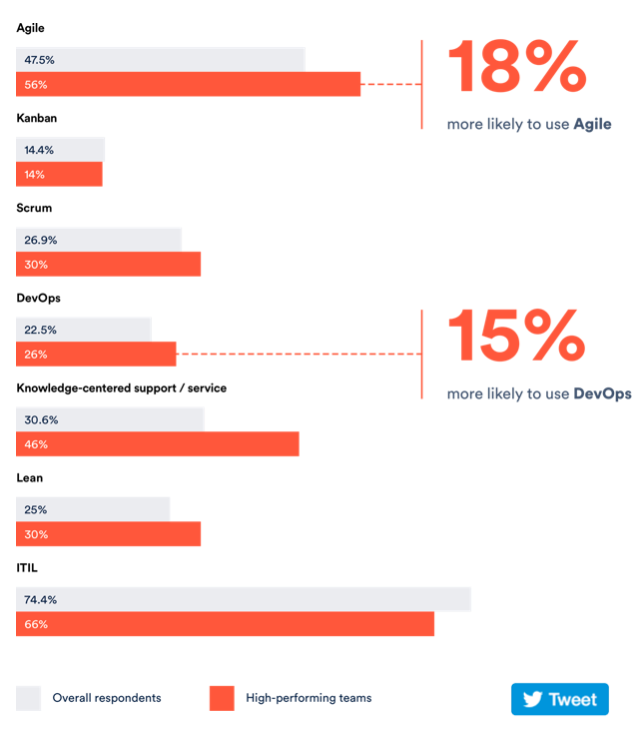At Atlassian, our mission is to unleash the potential in every team. Helping IT teams be their best is a big part of that mission. We understand that our customer’s success doesn’t just come from what technology products they purchase, but from their goals, processes, and culture. That’s why we partnered with HDI (The Help Desk Institute), the leading industry association for the technical support community, to sponsor first-hand research that goes beyond technology to understand what makes high-performing IT teams tick.
The role of IT is changing – for the better. With automation, more of what we do can now be done by a bot, from simple things like resetting a password to more complex ones like provisioning computing capacity during peak hours. In fact, McKinsey & Company estimates that as much as 45% of American jobs in certain categories could be automated within 20 years¹, representing a staggering $2,000,000,000,000 in lost wages. That’s 2 trillion dollars!
At the same time, the Cloud has removed IT from its role as the primary procurer of software. While IT teams could view these trends as a threat, we believe they open up an even bigger opportunity. Freed from traditional mundane tasks, IT can spend more time helping their business counterparts use technology to be more successful in their daily tasks and become a gatekeeper rather than a firefighter.
We surveyed almost 200 IT teams to understand their technology, process, and people habits. We asked them to self-identify how aligned they were with their business counterparts as well as their process maturity and defined high performing teams to be ones who did well in these competencies.
The top 5 things high-performing teams have in common:
- Put business first
- Master technology
- Invest in speed
- Make customers a priority
- Be proactive
Let’s dive in to a few of these! You can read more detailed results in the infographic.
Put business first
To understand if teams were aligned with the business, we asked them questions like how they prioritized projects, if they shared goals with the business, and how they measured success.
IT teams that rated themselves high on process maturity were 2x more likely to have goals oriented around business outcomes like revenue and 8x more likely to share goals with the business. This tells us that process-mature teams work closely with the business.

In fact, we believe this will be the most important skill serving IT teams of the future. Our hypothesis is that the most successful IT professionals will be masters of collaboration and keen students of business strategy as much as technology or ITIL.
Master technology
This sounds obvious, and in some ways the beauty of this tip is its simplicity. Being a technology guru at heart and driving technology change within the organization require different skill sets and it’s the latter that sets IT teams apart.
We found teams that are aligned with the business are 2x more likely to have a plan for digital transformation and 46% of these organizations see greater ROI on technology. These teams are also considerably more likely to invest in advanced technologies like machine learning, predictive analytics, and customer experience tools. Thanks to these IT teams, employees have the latest in collaboration, mobile, and productivity tools, and the company as a whole benefits.

They also invest more in the tools they use themselves. For example, they are 3 times more likely to have ITSM tools that are less than 2 years old.
Invest in speed
High-performing IT teams that are aligned with the business and mature in their processes care about speed. These teams are 18% more likely to use Agile in planning their work and 15% more likely to practice DevOps. Strangely, the only category in which they lagged behind (less than their less business-focused peers) was ITIL®. One could hypothesize that these teams care less about process for process sake and more about outcomes.

Be proactive
All the good intentions in the world aren’t going to cut it if the IT team has no room to breathe beyond day-to-day fire fighting. But reclaiming their day isn’t only about adding more headcount. You need to catch incidents before they snowball and actively fix root problems. Business focused teams are 2.5x more likely to have a problem management plan in place and have increased their usage of automation in the last two years. Avoid playing “wac-a-mole” with incidents and spending the entire day doing mundane tasks so your team is on their way to becoming high-performing.

So, what does your team need to do right now to stay ahead of the pack? Here are our recommendations:

We know one size doesn’t fit all and every team must take the journey that’s right for their size and shape. View the complete infographic to see additional behaviours and characteristics of high performing teams.
¹Four fundamentals of workplace automation – By Michael Chui, James Manyika, and Mehdi Miremadi – McKinsey.com
